OTC Hearing Aids: Why do Results Vary From Person to Person?

OTC Hearing Aids: Why do Results Vary From Person to Person?
- Amy
- otc hearing aids, bluetooth hearing aids, self-fitting hearing aids, TWS hearing aids, professional hearing aids
The emergence of over-the-counter (OTC) hearing aids has brought convenience to more people with mild to moderate hearing loss. However, there is a phenomenon that the same Bluetooth hearing aid can have very different results for different people. Why is this?
Unique ‘Ear Map’: Solving the Mystery of Individual Differences
Just as there are no two identical leaves, the structure of each person's ear is also different. This includes:
Cochlear size and shape: The cochlea is the key structure in the inner ear responsible for converting sound signals into nerve signals. The size and shape of the cochlea directly affects the reception and processing of sound. The strength of the neural signals produced by the same intensity of sound waves can vary greatly in different sizes and shapes of the cochlea.
Shape and size of the ear canal: The ear canal is the channel through which sound enters the cochlea. The length, width, and shape of the ear canal affect sound transmission and resonance. Narrow ear canals may result in under amplification of sound, while too wide canals may result in distortion of sound.
Middle Ear Structure: The auditory ossicles in the middle ear are responsible for transmitting sound vibrations to the inner ear. Differences in the structure of the middle ear can also affect the efficiency of sound transmission.
These subtle structural differences can result in the amplification and filtering of sound varying from person to person, even within the same model of OTC hearing aid.
The ‘Time Dimension’ of Hearing Loss: The Adaptive Challenge of the Brain
The duration of hearing loss in middle-aged and elderly people also has a direct impact on the effectiveness of affordable hearing aids.
Brain plasticity and the speech centre: The brain is plastic and can adapt its functions to the external environment. Long-term mild-to-moderate hearing loss can lead to deterioration or functional changes in the areas of the brain responsible for processing speech information. This means that even if professional hearing aids successfully amplify sounds, the brain may have difficulty effectively decoding and understanding these sound signals, especially if the hearing loss is prolonged.
Neural pathway reconstruction: Even after hearing is restored, it takes time for the brain to rebuild damaged neural pathways and relearn how to process sound information effectively. This process takes time and training, which explains why some people take a longer time to get used to rechargeable hearing aids, or even fail to do so.

Self-fitting TWS Hearing Aid Service: Customised Hearing Solutions
Because of the individual differences mentioned above, it is often difficult for a simple ‘one-size-fits-all’ OTC hearing aid to meet the needs of all users. That's why we've launched our self-fitting hearing aid service.
Our service focuses on:
Personalised hearing assessment: We offer more accurate online hearing tests and remote professional consultations to help you understand the type and extent of your hearing loss.
Customised sound tuning: Based on your individual audiogram and needs, we offer flexible sound parameter adjustments to ensure that your hearing aids provide you with the best possible hearing experience, rather than one-size-fits-all preset parameters.
Ongoing remote support: We provide ongoing remote technical support and instruction to help you adapt to and use your hearing aids.
Multi-function service: We support multiple volume adjustments, four modes, each mode with noise cancellation, to solve the shortcomings of a single function can not meet the use of multiple scenarios. Bluetooth with Bluetooth streaming media, a good solution to your daily life needs.
Through the self-fitting hearing aid service, we can better consider each person's individual differences, tailor the most suitable hearing solution for you, and maximise the effect and comfort of hearing aid use. You don't need to spend a lot of money on hearing aids with high trial and error costs by compromising the quality of other areas of your life!
Say goodbye to ‘trial and error’ and let's find your clarity together!








